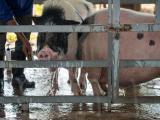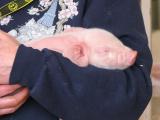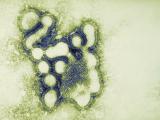Dec 28, 2011 (CIDRAP News) – Alongside last week's confirmation of another novel flu infection with an H3N2 variant, the US Centers for Disease Control and Prevention (CDC) launched a series of documents to advise health and lab workers on how to identify and report new cases.
On Dec 23 the CDC confirmed two more novel flu infections, including in a West Virginia child with a swine-origin H3N2 reassortant strain (H3N2v) that includes the M gene from the 2009 H1N1 virus. The youngster was a daycare contact of an H3N2v case reported on Dec 9, and the newly confirmed case pushed the nation's H3N2v total to 12 so far.
The other novel flu infection involved a swine-origin H1N1 variant (H1N1v) that had also acquired the M gene from the 2009 H1N1 virus. The CDC said the patient, an adult from Wisconsin who had occupational exposure to swine, was the first detection of the H1N1v strain in a human.
On the same day the CDC announced the two novel flu cases, it released documents that address preventing seasonal and H3N2v in healthcare settings, interim guidance on H3N2v specimen collection and testing, and interim case definitions for investigating H3N2v infections.
Most H3N2v infections have been mild, and only 3 of the 12 patients were hospitalized, the CDC said. Though it's not clear if cases will become more common, it's possible that healthcare providers will care for patients who have H3N2v infections, it added.
So far there is no evidence that H3N2v transmission characteristics are different from seasonal flu, so the CDC advises that facilities use the same infection control procedures as for seasonal flu to help guard against the spread of H3N2v, including the vaccination of healthcare workers. However, it added that the seasonal flu vaccine may provide limited protection against H3N2v in adults and no protection in children.
Given that limited person-to-person spread of H3N2v seems to be occurring, especially in children, the CDC released interim guidance designed to streamline its detection and investigation. It advised state and local health departments to use the CDC's real-time reverse transcriptase polymerase chain reaction (rRT-PCR) panel to screen for influenza A, influenza B, and ribonuclease P (an indicator of specimen adequacy), then use its influenza A subtyping kit, employing all primer and probe sets.
The CDC recommended that states increase the collection of respiratory specimens from patients with flulike illnesses who fall into certain high-priority groups, including children in childcare and school settings, unusual or severe flulike illness presentations (especially in kids), and medically attended flulike illnesses and acute respiratory infections in children.
Interim recommendations for collecting respiratory specimens for patients with suspected H3N2v infections are consistent with those for seasonal flu, the CDC said. It added that the duration of H3N2v shedding is unknown, and until more data are available, infected patients should be assumed to be contagious for up to 7 days from illness onset.
It said molecular assays may detect novel influenza A viruses but will not differentiate them from seasonal strains and may give an unsubtypable result, which should be forwarded to state or local labs for additional testing. Molecular assays may give a false-positive result for human H3 viruses, according to the CDC.
Rapid and immunofluorecense tests have unknown sensitivity and specificity to the H3N2v virus, and negative results from either test don't rule out flu infections in patients with signs and symptoms that suggest influenza.
The CDC said H3N2v viruses will be positive for the nucleoprotein (NP) gene (pdmInfA), influenza A, and seasonal influenza A (H3) targets of the CDC's rRT-PCR diagnostic panel. All suspected novel influenza A and H3N2v samples should be sent to the CDC for confirmational testing, it said. "Confirmation of influenza A (H3N2)v virus is performed only at CDC at this time."
The agency urged health departments to conduct contact tracing of confirmed, probable, or suspected H3N2v cases and provided definitions for the three levels of cases in a separate document. It asked health departments to notify the CDC about all suspected and probable H3N2v infections within 24 hours of identification.
The CDC defined a suspected H3N2v case as an acute respiratory illness in a patient who has an epidemiologic link to a confirmed case or got sick within 7 days of swine exposure.
It said a probable case is in a patient whose respiratory sample tested positive on the CDC RT-PCR flu panel for influenza A, pandemic influenza A, and H3, but negative for influenza B, pandemic H1, and H1. Also, a probable case could be in a person who has an acute respiratory infection and a link to a confirmed H3N2v case and whose diagnostic test is positive for influenza A (H3) or influenza A (no subtype tested or detected).
In a related development, the CDC updated its background information on swine influenza for pork producers and farmers, incorporating the latest information about novel influenza A viruses, urging people to take precautions when pigs and animal handlers have respiratory illnesses.
See also:
Dec 23 CDC prevention strategies for seasonal and H3N2v influenza in healthcare settings
Dec 23 CDC interim guidance for H3N2v specimen collection
Dec 23 CDC interim guidance for testing patients who have a suspected H3N2v infection
Dec 23 CDC interim guidance on H3N2v case definitions
Dec 23 CDC information for pork producers and farmers
Dec 23 CIDRAP News story "CDC reports two more novel flu infections"




















